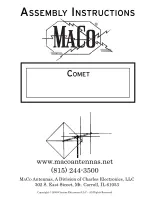
Always remember that safety comes first! That´s why you need to find
a clear and open space away from power lines. As part of the antenna is made
of fiberglass, wear gloves to handle the tubes to avoid skin irritation. Its also
important to be aware of loose and sharp pieces, as they may hurt your eyes. .
Children may be able to help you with the assembly, but pets will
certainly get in the way. You have no idea how much cats love playing with the
wires and parts of this antenna! Keep the kitties away!
Follow all these steps and safety instructions to properly set up your
Cobweb and go on air!
If you intend to mount this antenna in a vacant lot or in a yard covered
with grass or dirt, we suggest extending a tarpaulin that will help a lot not to
lose any parts that might fall off.
BEFORE STARTING!
This antenna is very light and can be easily assembled by one one
person. The estimated time of assembly is 60 to 90 minutes and to
disassemble, 40 minutes. If you have a tripod with a mast or a pipe
approximately 1.7m long (5.5 feet), it could be a good idea to use it as a
provisory structure to easily assemble and set the initial adjustments.
4
17
( ) The largest antenna is the 40 meter band and has a 300kHz band-
ends of the wire suspended (dropped) to reach the frequency of the
beginning of the band.
( ) In 17 m band, we have the same situation as the 12 m. A bandwidth
and laborious. That's because it's a very small bandwidth (on-
to adjust this band.
( ) 15 meter band has a bandwidth of 450kHz. Choose a sub-band of
the ressonant frequency many kHz. You will need a lot of patience
preference. Remember that a few inches can move the ressonant
frequency many kHz.
your preference and try to adjust it in that segment.
of just 100kHz (28,068 to 28,168 kHz). Adjust in the center of the
band.
( ) In 20 meter (14,000 to 14,350kHz) adjust in the segment of your
( ) The 3 0 meter band is the shortest of all. With only 50kHz (10,100
ly 100 kHz) from 24,890 to 24,990 kHz. A few inches can move
( ) In case of the 12 meter antenna, the adjustment can be very critical
to 10,150kHz) be very patient to adjust right in the center.
width. You will notice that the adjustment is not so sensitive. Ad-
just to the segment of your choice. If needed, you can leave the
Be careful not to overstretch each wire of the 10 to 40 meter
bands when attaching the ends to the spacers so as not to stress
the fiber structure. It is normal for each antenna element to have
a certain sag. This will not affect the operation.
Use the table on the last page
of this manual to adjust the
center frequencies of each band.
This table was based from our
prototype and may change in
a function of various factors such as
antenna height and closer objects.
Example of how to adjust the wires
over the plastic spacer
Ÿ
Do not handle or install your antenna near power lines
Ÿ
Wear gloves when handling fiberglass tubes to avoid possible
irritations or allergies that may be provoked by fiberglass particles
Ÿ
Do not touch the antenna when the radio is trasmitting
Ÿ
Always use proctetive equipment when installing this product in
high places
TOOLS AND ACCESSORIES NEEDES
(not supplied)
Ÿ
Small plier
Ÿ
Wrench or 8 and 10mm nut driver
Ÿ
Mast, tower or tripod and mounting hardware
Ÿ
Silicone sealant
Ÿ
Coaxial cable with male connector (PL-259)




























